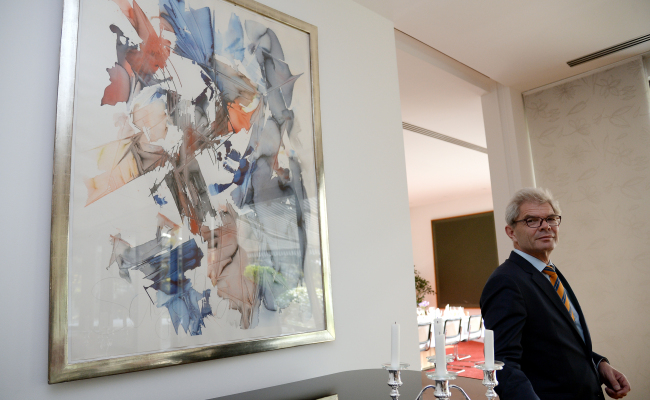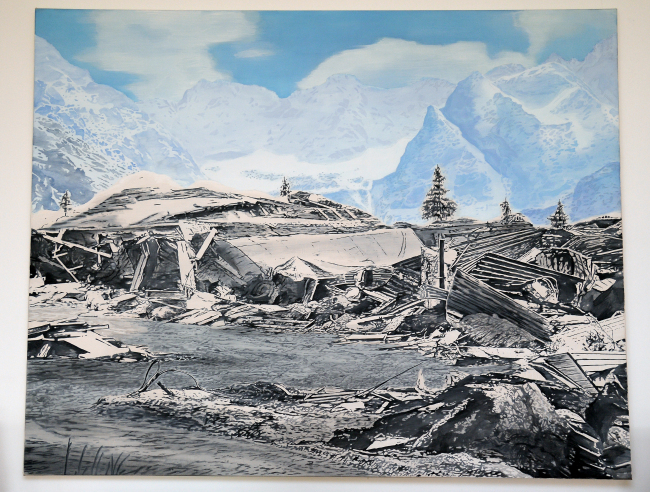Art at German envoy’s residence augurs hope for inter-Korean ties
By Korea HeraldPublished : May 14, 2014 - 20:32

This is the first in a series of articles in which foreign envoys to Korea show the art of their countries displayed in their homes. ― Ed.
The hilltop garden at the residence of the German ambassador on Mount Bugaksan commands a panoramic view of the elegant homes peppering the landscape of the exclusive Seongbuk-dong neighborhood below.
A look inside reveals a gentle and optimistic picture of a possible future for South Korea, a message that is conveyed on the walls of the ambassador’s home: reunification of the Korean Peninsula is not only beneficial politically, but also socially and, indeed, artistically.
“The German experience in unification is a positive message, it would seem to me, for the Korean people,” German Ambassador Rolf Mafael said during an interview with The Korea Herald at his home.
Nearly all of the artwork that decorates the ambassador’s home is by East German artists.
Many of the artists are either from East German states, referred to as “Neue Lander,” or worked most of their lives there. Many are also from the city of Dresden.
The hilltop garden at the residence of the German ambassador on Mount Bugaksan commands a panoramic view of the elegant homes peppering the landscape of the exclusive Seongbuk-dong neighborhood below.
A look inside reveals a gentle and optimistic picture of a possible future for South Korea, a message that is conveyed on the walls of the ambassador’s home: reunification of the Korean Peninsula is not only beneficial politically, but also socially and, indeed, artistically.
“The German experience in unification is a positive message, it would seem to me, for the Korean people,” German Ambassador Rolf Mafael said during an interview with The Korea Herald at his home.
Nearly all of the artwork that decorates the ambassador’s home is by East German artists.
Many of the artists are either from East German states, referred to as “Neue Lander,” or worked most of their lives there. Many are also from the city of Dresden.

The painting “Panorama Bar” (2005) by Markus Draper is a good example.
The large painting in the salon, where most of the receptions held at the residence take place, depicts the Alps stoically looking down on a natural catastrophe, the destructive power of a hurricane. It is prominently displayed in the room.
Draper taught art at the University of Dresden, the city of his birth. The painting exults in the power of nature but also its majesty, with the serenity and beauty of mountains in the background against the ruins wrought by nature in the foreground.

A painting by another Dresdner is “A Mountain Forest” (1988) by Max Uhlig. It hangs above a long slender table beside “Panorama Bar.”
Uhlig’s portrayal of nature in “A Mountain Forest” is reminiscent of a still life. In addition to landscapes, he produces many portraits using densely woven lines and strokes to represent both himself and his models.
Born in 1937, Uhlig is an active and well-respected German painter. Often described as the “draftsman of prints,” his preferred mediums are lithography and etching. Uhlig received the prestigious Hans Theo Richter Prize from the Saxon Academy of Art in 1998.
The salon faces south toward a glass wall some 30 meters wide, looking out on the garden. The residence itself is located in the verdant hills of Seongbuk-dong in northeastern Seoul. It was designed to be functional yet symbolic, tucked comfortably in its green mountainous surroundings.
Paik Young-hoon, the Korean-German interpreter who accompanied former President Park Chung-hee on the first visit to Germany by a South Korean head of state, was a key person behind early network-building between the two countries. He helped the then-West German Embassy relocate the ambassador’s residence.
The property for the residence was purchased in 1970, and construction of the home was completed years later in 1977, at a time when the Seoul government looked to develop the area for upscale homes.
The German Embassy was one of the first to build there. When construction began in the 1970s, Seongbuk-dong was known just for its forested hillsides and Chongboksa and Gyeongboksa temples.
Now the hills are crisscrossed with winding narrow roads, and as many as 30 foreign ambassadors reside in the neighborhood.
The actual architect of the home is unknown, as it was designed by the Agency for Federal Government Buildings, Germany’s organization specifically tasked with building diplomatic missions and residences.
“Germany has proven that not only is unification possible. You can also overcome the economic difficulties within a reasonable time frame, and then emerge stronger than before.” German reunification occurred in 1990 with the end of the Cold War.
Dresden, the capital of the East German state of Saxony, plays a prominent role in the art that decorates the residence, as well as a role in South Korean-German networks.
“There is a kind of line that this embassy has been following for over a decade now. That is, the continuous effort to support the Neue Lander. That means the former East Germany cities and states,” Mafael said.
“We are very happy about their strong presence here, especially of Saxony and Saxe-Anhalt. The first residence concert last year was with a soprano singer from the Saxon State Opera, followed by concerts of an ensemble from the Dresden Symphony Orchestra. Additionally, the Dresden vice mayor, whose South Korean wife is an opera singer, travels to Korea quite frequently,” he said, adding that Dresden and Leipzig, another East German city, will most likely cohost Germany’s National Day reception here in Seoul in October.
By Philip Iglauer (ephilip2014@heraldcorp.com)
-
Articles by Korea Herald



















![[Today’s K-pop] Treasure to publish magazine for debut anniversary](http://res.heraldm.com/phpwas/restmb_idxmake.php?idx=642&simg=/content/image/2024/07/26/20240726050551_0.jpg&u=)